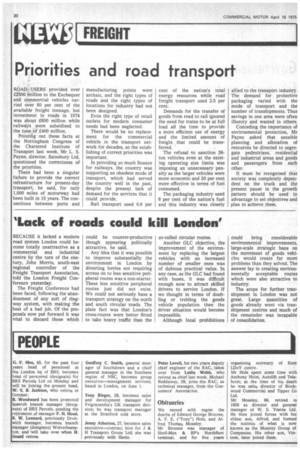Priorities and road transport
Page 22

If you've noticed an error in this article please click here to report it so we can fix it.
ROAD USERS provided over £2500 million to the Exchequer and commercial vehicles carried over 80 per cent of the available freight tonnage, but investment in roads in 1974 was about £600 million while railways were subsidised to the tune of E400 Pointing out these facts at the Nottingham Congress of the Chartered Institute of Transport last week, Mr L. S. Payne, director, Sainsbury Ltd, questioned the correctness of the priorities.
There had been a singular failure to provide the correct infrastructure for present-day transport, he said, for only 1,000 miles of motorway had been built in 15 years. The connections between ports and manufacturing points were archaic, and the right types of roads and the right types of locations for industry had not been designed.
Even the right type of retail outlets for modern consumer needs had been neglected.
There would be no replacement for the commercial vehicle in the transport network for decades, so the establishing of correct priorities was important.
In providing so much finance for railways, the country was supporting an obsolete mode of transport, which had served the country well in the past, despite the present lack of demand for the services that it could provide.
Rail transport used 0.8 per cent of the nation's total energy resources while road freight transport used 2.5 per cent.
Demands for the transfer of goods from road to rail ignored the need for trains to be at full load all the time to provide a more efficient use of energy and the limited amount of freight that could be transferred.
The refusal to sanction 38' ton vehicles even at the existing operating size limits was imposing an unnecessary penalty as the larger vehicles were more economic and 20 per cent more effective in terms of fuel consumed.
The packaging industry used 6 per cent of the nation's fuel and this industry was closely allied to the transport industry. The demand for protective packaging varied with the mode of transport and the number of transhipments. Thus savings in one area were often illusory and wasted in others.
Conceding the importance of environmental protection, Mr Payne asked that sensible planning and allocation of resources be directed to segregate pedestrians, residential and industrial areas and goods and passengers from each other.
It must be recognised that society was completely dependent on the truck and the present pause in the growth pattern should be used to advantage to set objectives and plan to achieve them.








































































































































